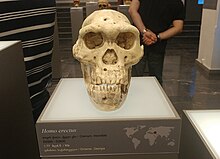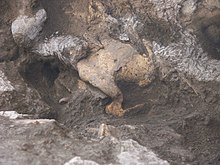195:
239:
290:
387:, Georgian and University of Zurich researchers were prompted to examine normal variations in modern human skulls and chimpanzees skulls. They found that while they looked different from one another, the great variations among all Dmanisi skulls were no greater than those seen among modern people and among chimpanzees. Consequently, it was entirely possible that such a discrepancy could be found in
38:
280:
are massive with the right one displaying many traces of deformations, probably due to fractures and injuries. Researchers estimate that the height of the individual was between 146 centimetres (4.79 ft) and 166 centimetres (5.45 ft) and his weight between 47 kilograms (104 lb) and 50
375:
of all the
Dmanisi skulls is so large that had they been discovered on different archaeological sites, they most likely would have been classified as different species. However, all Dmanisi skulls have the same age and have been found at exactly the same place.
507:
David
Lordkipanidze, Marcia S. Ponce de Leòn, Ann Margvelashvili, Yoel Rak, G. Philip Rightmire, Abesalom Vekua, Christoph P. E. Zollikofer (18 October 2013). "A Complete Skull from Dmanisi, Georgia, and the Evolutionary Biology of Early Homo".
647:
Lahr, M.M., 2010. “Saharan
Corridors and Their Role in the Evolutionary Geography of ‘Out of Africa I’”. In: A. Baden et al. (Eds.), Out of Africa I: The First Hominin Colonization of Eurasia. Springer Netherlands,
320:. Thus, the vast majority of archaeological effort was disproportionately focused on Africa. The Dmanisi archeological site is the earliest hominin site out of Africa and the analysis of its
659:
506:
341:
of the
Dmanisi skulls is major. It is worth noting that it was not associated with the discovery of skull 5, but with another specimen found at the same site, the
170:
The skull has been the cause of a paleontological controversy that is still ongoing as of 2017: many hominin fossils thought to be from different species such as
276:, which are prominent and massive, suggest that it was probably a male. Its face is one of the largest of any human ancestor discovered to date. The
559:
167:
comprised adult individuals with small brains but body mass, stature and limb proportions reaching the lower range limit of modern variation."
593:
757:
667:
150:. Described in a publication in October 2013, it is estimated to be about 1.8 million years old and is the most complete skull of a
621:
752:
747:
732:
269:
sizes of the other
Dmanisi skulls are between 601 cubic centimetres (36.7 in) and 730 cubic centimetres (45 in).
688:
577:
230:(D2600) found 5 years earlier. The final analysis of the discovery took many years and was only published in 2013.
163:
skull of that degree of antiquity. According to researchers, the discovery "provides the first evidence that early
464:
742:
727:
17:
226:, found in 2005, is the most complete specimen of them all. After further analysis, it was coupled with its
737:
372:
326:
384:
358:
321:
553:
470:
238:
517:
313:
8:
242:
215:
203:
183:
112:
521:
182:
may not have been separate species at all. Rather, they may have been a single evolving
598:
541:
338:
194:
533:
334:
as far back as 1.85 million years ago. All of the 5 skulls are roughly the same age.
309:
211:
141:
94:
545:
525:
396:
357:
with its comparatively tiny 546 cubic centimetres (33.3 in) brain compared to
254:
172:
578:
Skull suggests three early human species were one : Nature News & Comment
438:
431:
394:
This discovery led the scientists to suggest that two species of early hominins,
317:
297:
277:
133:
721:
703:
690:
529:
537:
457:
408:
402:
266:
258:
178:
146:
71:
222:. Since then, five early hominin skulls have been discovered at the site.
151:
257:
male, (546 cubic centimetres (33.3 in)) all the characteristics of
289:
626:
218:
about 90 kilometres (56 mi) southwest of the country's capital,
361:
found at the site, suggests that the earliest species of the genus
305:
227:
308:
had been restricted to the
African continent for the whole of the
294:
246:
219:
207:
160:
137:
90:
348:
331:
342:
412:. This is an ongoing debate among the scientific community.
363:
155:
37:
337:
Consequently, the paleontological significance of the
206:
found traces of early human occupation in the cave at
651:
719:
660:"Beautiful Skull Spurs Debate on Human History"
622:"Skull discovery sheds light on human species"
415:
594:"Skull Fossil Suggests Simpler Human Lineage"
349:Controversy and significance of the discovery
558:: CS1 maint: multiple names: authors list (
316:), only migrating out during a phase named
253:Despite a brain volume the size of a large
233:
36:
587:
585:
502:
500:
498:
496:
494:
492:
490:
488:
304:Until the 1980s, scientists assumed that
189:
641:
592:Wilford, John Noble (October 17, 2013).
573:
571:
569:
367:were actually subspecies of the species
288:
237:
193:
591:
324:showed that some hominins, chiefly the
14:
720:
657:
619:
582:
485:
379:Faced with the wide variation between
245:(centre) on the archeological site at
159:species, and the first complete adult
613:
566:
420:The five Dmanisi skulls are named:
24:
620:Watson, Traci (October 17, 2013).
25:
769:
758:Paleontology in Georgia (country)
658:Switek, Brian (17 October 2013).
465:List of human evolution fossils
353:The Dmanisi skulls, especially
272:The cranial superstructures of
49:
13:
1:
753:Prehistoric mammals of Europe
748:Prehistoric Georgia (country)
733:Fossil taxa described in 2013
478:
202:In 1991, Georgian scientist
7:
450:
416:List of Dmanisi 5 specimens
10:
774:
42:Skull 5 in National Museum
293:Stone tools found on the
284:
281:kilograms (110 lb).
108:
100:
86:
78:
66:
58:
47:
35:
234:Description of the skull
144:and classified as early
530:10.1126/science.1238484
345:, also known as D2700.
261:are clearly visible on
327:Homo erectus georgicus
301:
250:
199:
190:Discovery of the skull
704:41.33083°N 44.20306°E
471:List of human fossils
445:D4500/D2600 (skull 5)
406:, were actually both
292:
241:
197:
743:Pleistocene primates
728:Homo erectus fossils
427:D2282/D211 (skull 2)
700: /
670:on October 17, 2013
664:National Geographic
522:2013Sci...342..326L
371:. The variation in
243:David Lordkipanidze
216:archaeological site
204:David Lordkipanidze
134:one of five skulls
113:David Lordkipanidze
32:
709:41.33083; 44.20306
599:The New York Times
302:
251:
214:: a hamlet and an
200:
30:
738:Pliocene primates
516:(6156): 326–331.
312:(until about 0.8
310:Early Pleistocene
118:
117:
82:1.8 million years
16:(Redirected from
765:
715:
714:
712:
711:
710:
705:
701:
698:
697:
696:
693:
680:
679:
677:
675:
666:. Archived from
655:
649:
645:
639:
638:
636:
634:
617:
611:
610:
608:
606:
589:
580:
575:
564:
563:
557:
549:
504:
397:Homo rudolfensis
278:zygomatic arches
255:Australopithecus
173:Homo rudolfensis
124:, also known as
87:Place discovered
51:
40:
33:
29:
21:
773:
772:
768:
767:
766:
764:
763:
762:
718:
717:
708:
706:
702:
699:
694:
691:
689:
687:
686:
684:
683:
673:
671:
656:
652:
646:
642:
632:
630:
618:
614:
604:
602:
590:
583:
576:
567:
551:
550:
505:
486:
481:
453:
424:D2280 (skull 1)
418:
351:
343:Dmanisi Skull 3
318:Out of Africa I
298:paleontological
287:
236:
192:
101:Date discovered
62:Dmanisi skull 5
43:
31:Dmanisi skull 5
28:
23:
22:
15:
12:
11:
5:
771:
761:
760:
755:
750:
745:
740:
735:
730:
682:
681:
650:
640:
612:
581:
565:
483:
482:
480:
477:
476:
475:
474:
473:
461:
452:
449:
448:
447:
442:
435:
428:
425:
417:
414:
385:Dmanisi skulls
383:and the other
350:
347:
286:
283:
235:
232:
191:
188:
136:discovered in
116:
115:
110:
106:
105:
102:
98:
97:
88:
84:
83:
80:
76:
75:
68:
64:
63:
60:
56:
55:
52:
45:
44:
41:
27:Hominin fossil
26:
9:
6:
4:
3:
2:
770:
759:
756:
754:
751:
749:
746:
744:
741:
739:
736:
734:
731:
729:
726:
725:
723:
716:
713:
669:
665:
661:
654:
644:
629:
628:
623:
616:
601:
600:
595:
588:
586:
579:
574:
572:
570:
561:
555:
547:
543:
539:
535:
531:
527:
523:
519:
515:
511:
503:
501:
499:
497:
495:
493:
491:
489:
484:
472:
469:
468:
467:
466:
462:
460:
459:
455:
454:
446:
443:
440:
437:D3444/D3900 (
436:
433:
430:D2700/D2735 (
429:
426:
423:
422:
421:
413:
411:
410:
405:
404:
399:
398:
392:
390:
386:
382:
377:
374:
370:
366:
365:
360:
356:
346:
344:
340:
335:
333:
329:
328:
323:
319:
315:
311:
307:
299:
296:
291:
282:
279:
275:
270:
268:
264:
260:
256:
248:
244:
240:
231:
229:
225:
221:
217:
213:
209:
205:
196:
187:
185:
181:
180:
175:
174:
168:
166:
162:
158:
157:
153:
149:
148:
143:
139:
135:
131:
127:
123:
122:Dmanisi skull
114:
111:
109:Discovered by
107:
103:
99:
96:
92:
89:
85:
81:
77:
74:
73:
69:
65:
61:
57:
53:
46:
39:
34:
19:
18:Dmanisi skull
685:
674:22 September
672:. Retrieved
668:the original
663:
653:
643:
631:. Retrieved
625:
615:
603:. Retrieved
597:
554:cite journal
513:
509:
463:
458:Homo erectus
456:
444:
419:
409:Homo erectus
407:
403:Homo habilis
401:
395:
393:
389:Homo erectus
388:
380:
378:
368:
362:
359:other skulls
354:
352:
336:
325:
303:
273:
271:
262:
259:Homo erectus
252:
223:
201:
179:Homo habilis
177:
171:
169:
164:
154:
147:Homo erectus
145:
129:
125:
121:
119:
72:Homo erectus
70:
707: /
633:October 18,
605:October 18,
198:Excavation.
152:Pleistocene
59:Common name
722:Categories
695:44°12′11″E
692:41°19′51″N
479:References
373:morphology
627:USA Today
330:had left
322:artifacts
267:braincase
546:20435482
538:24136960
451:See also
306:hominins
228:mandible
48:Catalog
518:Bibcode
510:Science
439:skull 4
432:skull 3
381:Skull 5
369:erectus
355:Skull 5
295:Dmanisi
274:Skull 5
263:Skull 5
247:Dmanisi
224:Skull 5
220:Tbilisi
212:Georgia
208:Dmanisi
184:lineage
161:hominin
142:Georgia
138:Dmanisi
126:Skull 5
95:Georgia
91:Dmanisi
67:Species
648:27–46.
544:
536:
339:dating
332:Africa
285:Dating
265:. The
249:, 2010
542:S2CID
400:and
132:, is
130:D4500
54:D4500
676:2014
635:2013
607:2013
560:link
534:PMID
364:Homo
300:site
165:Homo
156:Homo
120:The
104:2005
526:doi
514:342
210:in
176:or
128:or
93:in
79:Age
50:no.
724::
662:.
624:.
596:.
584:^
568:^
556:}}
552:{{
540:.
532:.
524:.
512:.
487:^
391:.
314:Ma
186:.
140:,
678:.
637:.
609:.
562:)
548:.
528::
520::
441:)
434:)
20:)
Text is available under the Creative Commons Attribution-ShareAlike License. Additional terms may apply.


